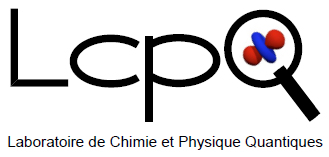Dynamical simulation of collision‐induced dissociation of water – pyrene clusters
THEORETICAL CHEMISTRY AND COMPUTATIONAL MODELING

Lab: LCPQ
Duration: 5 months full-time internship
6 months full-time internship
Latest starting date: 01/02/2024
Localisation: Laboratoire de Chimie et Physique Quantiques UMR 5626
118 Route de Narbonne Toulouse
Supervisors:
Mathias Rapacioli, CRCN - CNRS mathias.rapacioli@irsamc.ups-tlse.fr
Aude Simon, DR - CNRS aude.simon@irsamc.ups-tlse.fr
Work package:
Clusters of polycyclic aromatic hydrocarbons (PAHs) with water molecules are relevant systems in several scientific fields, including astrophysics and atmospheric sciences. It is therefore mandatory to characterize their formation and fragmentation processes. In a former work, we performed global explorations of the potential energy landscapes of neutral clusters (two PAHs and one to ten water molecules) using a density-functional-based tight-binding (DFTB) scheme. The identification of the main dissociation channels from the computed binding energies present major discrepancies with respect to the collision induced dissociations experiments on the same systems performed at the LCAR laboratory (S. Zamith et al.). This suggests that, beyond the binding energies analysis, the energy deposition process should be considered. To do so in the proposed project, the hired fellow will perform molecular dynamics simulations of water-PAH clusters impacted by Argon atoms, as done in the experiment, and the a posteriori computed mass spectra will be compared to the experimental ones. The trajectories analyses will allow to characterize the competition between fragmentation and energy redistribution inside the system.

References:
H. Leboucher, A. Simon, and M. Rapacioli. Structures and stabilities of pah clusters solvated by water aggregates: The case of the pyrene dimer. The Journal of Chemical Physics, 158, 11, 114308 (2023)
L. Zheng, S. Zamith, and M. Rapacioli. Dynamical simulation of collision- induced dissociation of pyrene dimer cation. Theoretical Chemistry Ac- counts, 140, 2, 19 (2021)
H. Leboucher, J. Mascetti, J. Noble, A. Simon*, ’Water clusters in interaction with corannulene in a rare gas matrix : structure, stability and IR spectra’, Contribution to Photochem Special Issue in Honor of Prof. Maciej J. Nowak, 2022, 2, 237-262 (open access, 10.3390/photochem2020018, HAL Id : hal-03689280)
A. Simon*, M. Rapacioli, J. Mascetti, F. Spiegelman ’Vibrational spectroscopy and molecular
dynamics of water monomer and dimer adsorbed on polycyclic aromatic hydrocarbons’, Phys.
Chem. Chem. Phys. 2012, 14 (19), 6771-6786 (10.1039/C2CP40321H)
Areas of expertise:
Astrochemistry, Molecular Dynamics, Quantum Chemistry
Required skills for the internship:
Familiar with Linux/Unix environment, Experience using quantum chemistry softwares and visualisation interfaces, quantum chemistry knowledge
